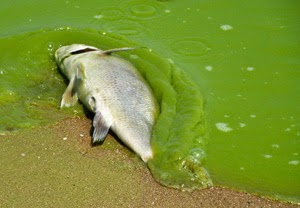
Just days after half a million Toledo residents were advised their water was too toxic to drink or bathe in (New York Times story), scientists released the annual measurement of the Gulf of Mexico Dead Zone, and the findings are grim (CNN Dead Zone story).
This year’s Dead Zone is estimated at 5,000 square miles—an area as big as the state of Connecticut, and three times larger than the 2015 goal established by a task force created to shrink the Dead Zone.
The crisis affecting water in Toledo, the Gulf of Mexico, and across the nation is the same: nitrogen and phosphorus pollution from big farms and sewage treatment plants.

In lakes and rivers, nitrogen and phosphorus pollution fuels the growth of stinking mats of algae that foul our waterways and beaches, and deprive the water of oxygen needed to support life. Algae can also contain toxins like the microcystin that poisoned Toledo’s drinking water and other toxins that have killed fish, livestock and pets.
Voluntary initiatives to tackle this national problem have failed. The failure of states and the feds to regulate this pollution has left all of us at risk. Prairie Rivers Network and our partners in the Mississippi River Collaborative petitioned US EPA for pollution limits in 2008, and then sued the agency in 2012 when it failed to address the problem. But even an EPA fix would not be enough.

Much of the increase in nitrogen and phosphorus pollution in recent years is coming from big farms that, thus far, have escaped regulation.
The Farm Bureau and other agricultural organizations have used money and lobbying power to ensure that the pollution from agriculture is exempt from many of the laws that protect our water. Yet Illinois could act to hold polluting farms accountable. It’s time to stop asking politely for polluters to do the right thing. We need rules that require everyone to keep pollution out of our water.







